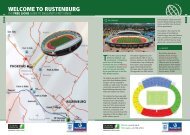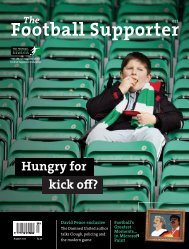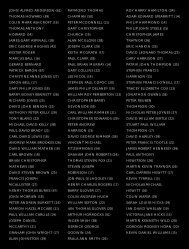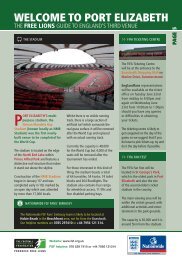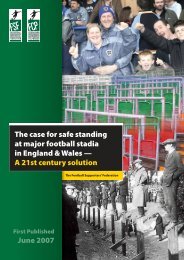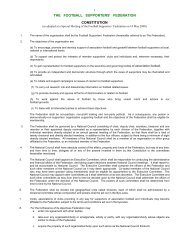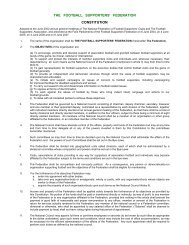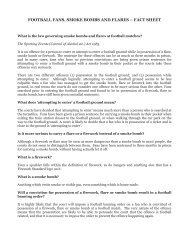Taylor Report - South Yorkshire Police
Taylor Report - South Yorkshire Police
Taylor Report - South Yorkshire Police
Create successful ePaper yourself
Turn your PDF publications into a flip-book with our unique Google optimized e-Paper software.
CHAPTERS<br />
LACK OF FIXED CAPACITIES FOR THE PENS<br />
136. In 1981, when the terrace was divided into three areas, Dr Eastwood gave the Club the figure of 2,200<br />
capacity for the centre pen. He based this on the Green Guide, making such allowances as he thought right. No<br />
doubt the numbers could have been counted in via the turnstiles if only that pen was in use or if such pens as<br />
were in use were filled sequentially, but not otherwise.<br />
137. After the 1985 changes, Dr Eastwood did not himself give any figures for the new pens 3 and 4.<br />
Someone on his staff however split the figure 2,200 into 1,200 for pen 3 and 1,000 for pen 4. Those figures did<br />
not even take account of the fact that pen 5 had been carved out of pen 4 which was bound to have a reducing<br />
effect on capacity. Nevertheless, the figures of 1,200 and 1,000 were put on a drawing emanating from<br />
Eastwood and Partners and the figures have been notionally regarded since as applicable by the Club and the<br />
police. They are in fact too high.<br />
138. Dr Nicholson, at the Research and Laboratory Services Division of the Health and Safety Executive,<br />
has calculated that the figures for pens 3 and 4 respectively would be 1,015 and 1,036 if the strength and<br />
spacing of the crush barriers had complied with the Green Guide. But they did not.<br />
Departures from the Green Guide<br />
139. In pen 3, four out of five gaps in the lines of crush barriers do not conform with paragraph 115 of the<br />
Green Guide (1986). In pen 4, nine out often do not conform. In particular, the spans taken out of the barriers<br />
in pen 3 in 1985 left gaps well in excess of the maximum of 1.4 metres prescribed. One gap was 57% wider than<br />
the Green Guide maximum. Moreover, that gap was in direct diagonal line from the mouth of the tunnel to the<br />
barrier which collapsed. Dr Eastwood justified these larger gaps by the absence of gangways. Fans had to be<br />
able to get in and out and standard gaps tended to get blocked up. The effect of his reasoning was that the<br />
absence of gangways, recognised as having a safety function, led to the sacrifice of a second safety feature,<br />
namely gaps of strictly limited width.<br />
140. Again, the removal of barrier 144 was bound, as Dr Eastwood conceded, to affect capacity. In fact it<br />
did more, as I shall indicate later.<br />
141. Capacity should also have taken account of two further departures from the Green Guide. If, as was<br />
the case, the perimeter gates were not regarded as exits, some 40% of those in pens 3 and 4 were more than 12<br />
metres from an exit (and there was no gangway) contrary to the aim of paragraph 96. Four out of five of the<br />
crush barriers in pen 3 and six out of nine in pen 4 were below the height prescribed in paragraph 110. These<br />
were the old barriers which had been repaired and plated where their bases had corroded and fresh concrete<br />
had been applied, raising the level of the steps. The point is not academic since, in the event, many fans were<br />
bent painfully over barriers under great pressure.<br />
142. Dr Nicholson calculated that when all relevant factors regarding the configuration and the Green<br />
Guide are taken into account, the maximum capacity for pen 3 should have been 822 and for pen 4, 871.<br />
Safety Certificate<br />
143. Whatever should have been the maximum capacities for pens 3 and 4, the fact is that no figures at all in<br />
respect of them were put into the Safety Certificate. Despite all the changes in layout of the fences and barriers,<br />
the two figures, 2,900 for the north-west terrace and 7,200 for the west terrace, have remained as the only<br />
maxima with which the Club has to comply.<br />
144. Section 2(1) of the Safety of Sports Grounds Act 1975 provides (so far as is relevant):<br />
"A Safety Certificate shall contain such terms and conditions as the local authority consider necessary or<br />
expedient to secure reasonable safety at the stadium when it is in use..."<br />
Section 2(2) provided (so far as is relevant):<br />
"Without prejudice to sub-section (1) above, a Safety Certificate-<br />
(a) shall specify the maximum number of spectators to be admitted to the stadium;<br />
(b) may specify the maximum number to be admitted to different parts of it;<br />
(c) shall include terms and conditions-<br />
... (iii) as to the number, strength and situation of any crush barriers."<br />
24



